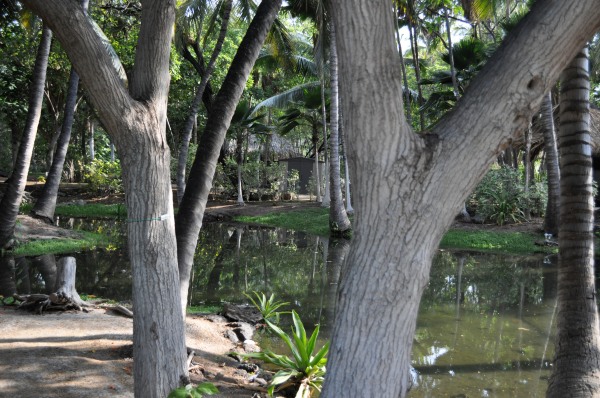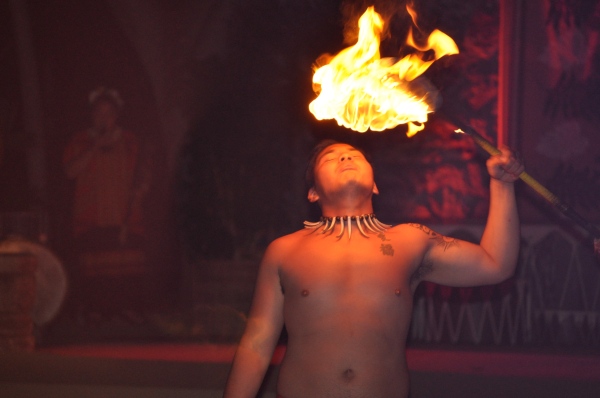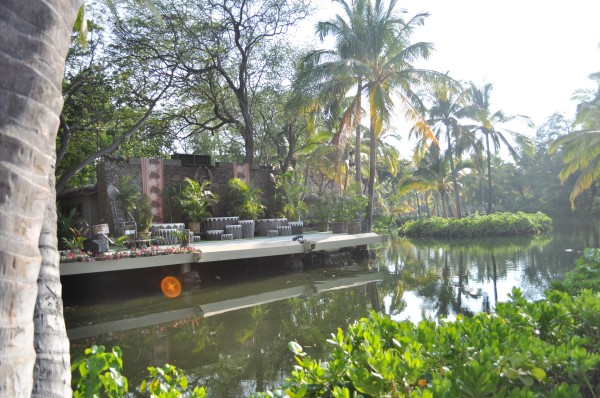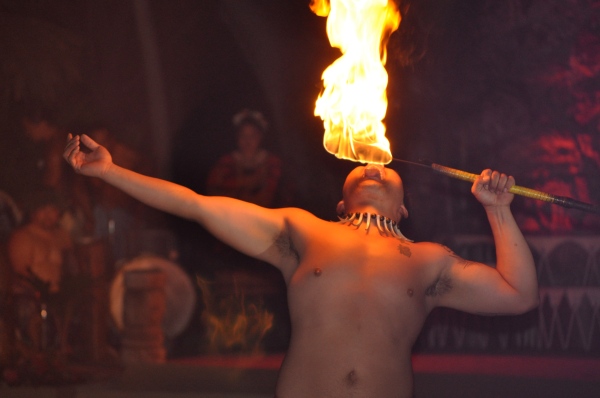An Authentic Hawaiian Luau at the Kona Village Resort
It could be one of the activities most associated with a trip to Hawaii, and the authentic Hawaiian luau—with its poi, hula dancers, and emu—was at the top of our “Must Do List” for Hawaii.
Because we were on the Big Island, we decided to take in the Kona Village Luau, ranked as one of the 1,000 Places to See in the U.S.A. & Canada Before You Die. The book even says the Kona Village Luau is the Big Island’s “longest-running and most authentic” luau, and, as we found out, the setting is straight out of South Pacific, with tiki-torch lights and lagoons dotting the landscape.
The person I made the luau reservations with said the luau began at 5:00 pm; however, we weren’t seated until 5:15 (or possibly later) and the entertainment didn’t start until 5:30—it’s worth noting that there were line ups for first-come-first-serve seating, though.
The evening then kicked off with some live music, followed by a demonstration of a coconut husking that balanced information and entertainment of a more comedic bent .
Guests were then shown a Polynesian earthen oven (umu) and a Hawaiian earthen oven (imu). If you end up at the Kona Village Luau alongside your little ones, move to the viewing area early to ensure they get a spot they can see from, or be prepared to wait until it’s cleared out to check out the ovens fully.
Following the cooking demonstration was the food itself. The buffet was spectacular and abundant; there was plenty for everyone and it was all fantastic. Although the main attractions to the buffet were the kalua pig from the imu, lomi lomi salmon and turkey from the umu, there were plenty of salads and vegetable dishes to satisfy the vegetarians among us. The buffet included Hawaiian-style macaroni salad (a staple in the islands), taro sweet bread, grass-fed Big Island teriyaki steak, chicken, mashed Hawaiian sweet potatoes, fresh fruits, poi, prawns, crab, veggies and tofu. To get an idea of how good everything was, you’d have to tuck into a plate yourself, and the local among us said that it was perfectly in line with what you’d actually see at Hawaiian luau being held among family and friends (at least ones who knew their way around the kitchen).
After dinner and dessert (which included a fantastic chocolate cake), the revue began. The show included enchanting dancing and singing from Polynesia, including Tahitian, Maori, Tongan and Samoan dance. One of the final dances was a spectacular fire dance. For those afraid of audience participation, there was very little required of the audience, other than the occasional chanting and a hula dance performed by willing children and a couple brave adults. No one has to take part in anything he or she doesn’t want to.
The dancing was mesmerizing, as was the music, and kept me entertained for the most part. I think I could listen to traditional Hawaiian music all day and not be bored of it. Meanwhile, the setting for the luau was lush, with plenty of trees and tranquil ponds to enjoy (and make guests contemplate how beautiful resorts in Hawaii are).
Some final thoughts:
Don’t except a heavy dose of history. If you are simply looking to be entertained, this luau will do it for you. The dancing and music were both fantastic. If, however, you are looking to learn a lot about the various Polynesian cultures or learn how the individual dances are different, this is not the place. Although there was some discussion about where each dance came from, and some comments about what the dance meant (i.e. that it was a war dance and the tongue at the end means you might be eaten), there wasn’t any in-depth commentary about the differences between the dances or how they relate to Hawaii. You’ll have to do your own research to figure that out, and that’s true for just about every luau in the Islands.
Don’t go to the luau as part of a busy day. We wanted to see the Friday luau (Kona Village also does a Wednesday luau, but Friday is the recommended one) so we went at the end of a long day that started with a journey to the Vancouver airport at 4:00 am (Pacific Time). By the time the luau was over at 8:30 pm Hawaiian time it was 11:30 pm my time and I was exhausted. By around 7:00 I started looking at my watch, praying for the time to go more quickly (not because of the entertainment but because I was so tired). If you go to a luau, make it the highlight of your day.
Don’t go to the luau extremely hungry. The temptation might be to eat less during the day so you have room in your stomach for the buffet food–don’t do this, at least not if you’re generally an early eater. We didn’t eat until at least 6:15 PM and, as far as I could tell, people only went to the buffet once. They provided chips on the table before dinner, but it’s not enough to satisfy extreme hunger. Because I was on the plane for most of the day, and because I thought we would be eating sooner at the luau, I barely had anything to eat prior to the luau. It’s a wonder I didn’t down all the chips and the bowl they were in (in my defense, I’m pretty sure it was made of coconut wood). Have something to eat in the afternoon before you go, with a plan of getting hungry when you go so you can try a little of everything, but don’t head out ravenous.
Don’t expect free drinks. You receive a free Mai Tai or guava-passionfruit punch with the price of admission, but after that the only thing that’s free is the water. Even the sodas and juices cost $3.00 (which was a bit disappointing, considering the cost of admission, the extreme heat and the size of the cups they used). That said, the servers made sure my water cup was repeatedly filled until after dinner, but I still felt thirsty.
In all, the luau was highly enjoyable and worth seeing at least once. It wasn’t at all cheesy, which is something I feared it might be. Rather it seemed authentic and the dancers and musicians had Herculean amounts of energy to get through the evening. They had most of the audience captivated. The food was exquisite. Despite a few minor quibbles (and they are minor) I would recommend that visitors to Hawaii enjoy at least one luau (and this is apparently the luau to take in).
Admission to the Kona Village Luau is free for guests staying at Kona Village Resort. For those not staying at Kona Village Resort, the cost is $98 for adults and children over the age of 13, $67 for children ages 6 to 12 and $40 for children ages 3 to 5. The cost includes entertainment, buffet dinner, welcome Mai Tai or fruit punch, complimentary flower lei, gratuity and free parking. Taxes are not included in the price. More information can be found on the luau brochure.
All photos courtesy K. Douglas






Great post, Heidi. “Luau” has always been one of those fuzzy terms in my mind and I’ve never bothered to learn exactly what it is. Now I know. You’re provided a lot of useful information here, as well as wonderful photos and commentary. My only question concerns the Umu picture, the Polynesian earthen oven: I can’t tell what’s there and how it’s being cooked.
Thanks!
Yeah, by the time we were able to get up close to see the umu, the food had already been removed–there was a demonstration, but I was at the very back and couldn’t see anything. I THINK (maybe my lovely co-writer can help me on this) that the umu was where the pig was cooked and my understanding is that it is a large hole in the ground filled with hot rocks and covered with a specific type of leaf that keeps the heat in and allows the pig to cook. But, having not been able to see or hear most of the demonstration, I’m not positive that’s what it was.